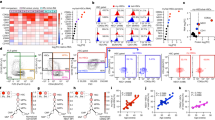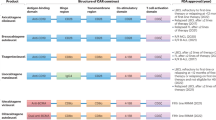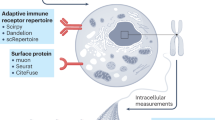Abstract
Women have been at the forefront of tremendous achievements in immunology in the past decade. However, disparities still exist, limiting upward potential and further advancements. As four NIH intramural women scientists who care deeply about scientific progress and the progress of women in our field, we review ongoing challenges and discuss potential approaches to help advance the promotion of women in the sciences.
This is a preview of subscription content, access via your institution
Access options
Access Nature and 54 other Nature Portfolio journals
Get Nature+, our best-value online-access subscription
$29.99 / 30 days
cancel any time
Subscribe to this journal
Receive 12 print issues and online access
$209.00 per year
only $17.42 per issue
Buy this article
- Purchase on Springer Link
- Instant access to full article PDF
Prices may be subject to local taxes which are calculated during checkout
Similar content being viewed by others
References
Harrison, O. J. et al. Commensal-specific T cell plasticity promotes rapid tissue adaptation to injury. Science 363, eaat6280 (2019).
Rosshart, S. P. et al. Laboratory mice born to wild mice have natural microbiota and model human immune responses. Science 365, eaaw4361 (2019).
Tirosh, O. et al. Expanded skin virome in DOCK8-deficient patients. Nat. Med. 24, 1815–1821 (2018).
Joglekar, P. & Segre, J. A. Building a translational microbiome toolbox. Cell 169, 378–380 (2017).
Iida, N. et al. Commensal bacteria control cancer response to therapy by modulating the tumor microenvironment. Science 342, 967–970 (2013).
Reynoso, G. V. et al. Lymph node conduits transport virions for rapid T cell activation. Nat. Immunol. 20, 602–612 (2019).
Ritter, A. T. et al. Cortical actin recovery at the immunological synapse leads to termination of lytic granule secretion in cytotoxic T lymphocytes. Proc. Natl Acad. Sci. USA 114, E6585–E6594 (2017).
Bohrer, A. C., Tocheny, C., Assmann, M., Ganusov, V. V. & Mayer-Barber, K. D. Cutting Edge: IL-1R1 mediates host resistance to Mycobacterium tuberculosis by trans-protection of infected cells. J. Immunol. 201, 1645–1650 (2018).
Castillo, J. C., Ferreira, A. B. B., Trisnadi, N. & Barillas-Mury, C. Activation of mosquito complement antiplasmodial response requires cellular immunity. Sci. Immunol. 2, eaal1505 (2017).
Chiramel, A. I. et al. TRIM5α restricts flavivirus replication by targeting the viral protease for proteasomal degradation. Cell Rep. 27, 3269–3283.e6 (2019).
Johnson, K. E. E. & Ghedin, E. Quantifying between-host transmission in influenza virus infections. Cold Spring Harb. Perspect. Med. https://doi.org/10.1101/cshperspect.a038422 (2019).
Kardava, L. et al. IgG3 regulates tissue-like memory B cells in HIV-infected individuals. Nat. Immunol. 19, 1001–1012 (2018).
Ramsuran, V. et al. Elevated HLA-A expression impairs HIV control through inhibition of NKG2A-expressing cells. Science 359, 86–90 (2018).
Riggle, B. A. et al. CD8+ T cells target cerebrovasculature in children with cerebral malaria. J. Clin. Invest. https://doi.org/10.1172/JCI133474 (2019).
Warburton, A. et al. HPV integration hijacks and multimerizes a cellular enhancer to generate a viral-cellular super-enhancer that drives high viral oncogene expression. PLoS Genet. 14, e1007179 (2018).
Jessop, F. et al. Temporal manipulation of mitochondrial function by virulent Francisella tularensis to limit inflammation and control cell death. Infect. Immun. 86, e00744-19 (2018).
Bhatia, B. et al. Infection history of the blood-meal host dictates pathogenic potential of the Lyme disease spirochete within the feeding tick vector. PLoS Pathog. 14, e1006959 (2018).
Boso, G. et al. Evolution of the rodent Trim5 cluster is marked by divergent paralogous expansions and independent acquisitions of TrimCyp fusions. Sci. Rep. 9, 11263 (2019).
Chen, Z. et al. Role of humoral immunity against hepatitis B virus core antigen in the pathogenesis of acute liver failure. Proc. Natl Acad. Sci. USA 115, E11369–E11378 (2018).
Faris, R., Moore, R. A., Ward, A., Sturdevant, D. E. & Priola, S. A. Mitochondrial respiration is impaired during late-stage hamster prion infection. J. Virol. 91, e00524-17 (2017).
Furuyama, W. & Marzi, A. Ebola virus: pathogenesis and countermeasure development. Annu. Rev. Virol. 6, 435–458 (2019).
Helmold Hait, S. et al. Early T follicular helper cell responses and germinal center reactions are associated with viremia control in immunized rhesus macaques. J. Virol. 93, e01687-18 (2019).
Lambert, L. H. et al. Antigen reversal identifies targets of opsonizing IgGs against pregnancy-associated malaria. Infect. Immun. 82, 4842–4853 (2014).
Lathrop, S. K. et al. Salmonella Typhimurium infection of human monocyte-derived macrophages. Curr. Protoc. Microbiol. 50, e56 (2018).
Matsuda, K. et al. A SIV molecular clone that targets the CNS and induces neuroAIDS in rhesus macaques. PLoS Pathog. 13, e1006538 (2017).
Percopo, C. M. et al. Critical adverse impact of IL-6 in acute pneumovirus infection. J. Immunol. 202, 871–882 (2019).
van Loben Sels, J. M. & Green, K. Y. The antigenic topology of norovirus as defined by B and T cell epitope mapping: implications for universal vaccines and therapeutics. Viruses 11, E432 (2019).
Winkler, C. W. et al. Neuronal maturation reduces the type I IFN response to orthobunyavirus infection and leads to increased apoptosis of human neurons. J. Neuroinflammation 16, 229 (2019).
Horai, R. et al. Microbiota-dependent activation of an autoreactive T cell receptor provokes autoimmunity in an immunologically privileged site. Immunity 43, 343–353 (2015).
Kwong, B. et al. T-bet-dependent NKp46+ innate lymphoid cells regulate the onset of TH17-induced neuroinflammation. Nat. Immunol. 18, 1117–1127 (2017).
Mistry, P. et al. Transcriptomic, epigenetic, and functional analyses implicate neutrophil diversity in the pathogenesis of systemic lupus erythematosus. Proc. Natl Acad. Sci. USA 116, 25222–25228 (2019).
Sun, W. et al. Antiviral adaptor MAVS promotes murine lupus with a B cell autonomous role. Front. Immunol. 10, 2452 (2019).
Dominguez, C., McCampbell, K. K., David, J. M. & Palena, C. Neutralization of IL-8 decreases tumor PMN-MDSCs and reduces mesenchymalization of claudin-low triple-negative breast cancer. JCI Insight 2, 94296 (2017).
Ishii, H. et al. miR-130a and miR-145 reprogram Gr-1+CD11b+ myeloid cells and inhibit tumor metastasis through improved host immunity. Nat. Commun. 9, 2611 (2018).
Zhu, F. et al. Autoreactive T cells and chronic fungal infection drive esophageal carcinogenesis. Cell Host Microbe 21, 478–493.e7 (2017).
Arango, D. et al. Acetylation of cytidine in mRNA promotes translation efficiency. Cell 175, 1872–1886.e24 (2018).
Oh, K.-S. et al. Anti-inflammatory chromatinscape suggests alternative mechanisms of glucocorticoid receptor action. Immunity 47, 298–309.e5 (2017).
Singh, A. et al. Noncoding variations in Cyp24a1 gene are associated with Klotho-mediated aging phenotypes in different strains of mice. Aging Cell 18, e12949 (2019).
Maul, R. W. et al. DNA polymerase iota functions in the generation of tandem mutations during somatic hypermutation of antibody genes. J. Exp. Med. 213, 1675–1683 (2016).
Prokunina-Olsson, L. Genetics of the human interferon lambda region. J. Interferon Cytokine Res. 39, 599–608 (2019).
Xiao, W. et al. Recurrent somatic JAK3 mutations in NK-cell enteropathy. Blood 134, 986–991 (2019).
Lamborn, I. T. et al. Recurrent rhinovirus infections in a child with inherited MDA5 deficiency. J. Exp. Med. 214, 1949–1972 (2017).
Lucas, C. L. et al. Dominant-activating germline mutations in the gene encoding the PI(3)K catalytic subunit p110δ result in T cell senescence and human immunodeficiency. Nat. Immunol. 15, 88–97 (2014).
Preite, S. et al. Hyperactivated PI3Kδ promotes self and commensal reactivity at the expense of optimal humoral immunity. Nat. Immunol. 19, 986–1000 (2018).
Zhou, Q. et al. Loss-of-function mutations in TNFAIP3 leading to A20 haploinsufficiency cause an early-onset autoinflammatory disease. Nat. Genet. 48, 67–73 (2016).
Dutzan, N. et al. A dysbiotic microbiome triggers TH17 cells to mediate oral mucosal immunopathology in mice and humans. Sci. Transl. Med. 10, eaat0797 (2018).
Weissler, K. A. & Frischmeyer-Guerrerio, P. A. Genetic evidence for the role of transforming growth factor-β in atopic phenotypes. Curr. Opin. Immunol. 60, 54–62 (2019).
Vaccari, M. et al. HIV vaccine candidate activation of hypoxia and the inflammasome in CD14+ monocytes is associated with a decreased risk of SIVmac251 acquisition. Nat. Med. 24, 847–856 (2018).
Cagigi, A. et al. Vaccine generation of protective Ebola antibodies and identification of conserved B-cell signatures. J. Infect. Dis. 218, S528–S536 (2018).
Carter, C. et al. Safety and immunogenicity of investigational seasonal influenza hemagglutinin DNA vaccine followed by trivalent inactivated vaccine administered intradermally or intramuscularly in healthy adults: an open-label randomized phase 1 clinical trial. PLoS One 14, e0222178 (2019).
Akkaya, M. et al. Second signals rescue B cells from activation-induced mitochondrial dysfunction and death. Nat. Immunol. 19, 871–884 (2018).
Arbore, G. et al. Complement receptor CD46 co-stimulates optimal human CD8+ T cell effector function via fatty acid metabolism. Nat. Commun. 9, 4186 (2018).
Clerc, I. et al. Entry of glucose- and glutamine-derived carbons into the citric acid cycle supports early steps of HIV-1 infection in CD4 T cells. Nat. Metab. 1, 717–730 (2019).
Gegonne, A. et al. Immature CD8 single-positive thymocytes are a molecularly distinct subpopulation, selectively dependent on BRD4 for their differentiation. Cell Rep. 24, 117–129 (2018).
Rodrigues, P. F. et al. Distinct progenitor lineages contribute to the heterogeneity of plasmacytoid dendritic cells. Nat. Immunol. 19, 711–722 (2018).
Dey, A. et al. BRD4 directs hematopoietic stem cell development and modulates macrophage inflammatory responses. EMBO J. 38, e100293 (2019).
Chen, Y. H. et al. Phosphatidylserine vesicles enable efficient en bloc transmission of enteroviruses. Cell 160, 619–630 (2015).
Khan, M. M. et al. Host-pathogen dynamics through targeted secretome analysis of stimulated macrophages. J. Proteomics 189, 34–38 (2018).
Sil, P., Muse, G. & Martinez, J. A ravenous defense: canonical and non-canonical autophagy in immunity. Curr. Opin. Immunol. 50, 21–31 (2018).
Fry, T. J. et al. CD22-targeted CAR T cells induce remission in B-ALL that is naive or resistant to CD19-targeted CAR immunotherapy. Nat. Med. 24, 20–28 (2018).
Kim, M. Y. et al. Genetic inactivation of CD33 in hematopoietic stem cells to enable CAR T cell immunotherapy for acute myeloid leukemia. Cell 173, 1439–1453.e19 (2018).
Kuang, F. L. et al. Benralizumab for PDGFRA-negative hypereosinophilic syndrome. N. Engl. J. Med. 380, 1336–1346 (2019).
Lisco, A. et al. Identification of rare HIV-1-infected patients with extreme CD4+ T cell decline despite ART-mediated viral suppression. JCI Insight 4, 127113 (2019).
Lo, M. K. et al. Remdesivir (GS-5734) protects African green monkeys from Nipah virus challenge. Sci. Transl. Med. 11, eaau9242 (2019).
Sanchez, G. A. M. et al. JAK1/2 inhibition with baricitinib in the treatment of autoinflammatory interferonopathies. J. Clin. Invest. 128, 3041–3052 (2018).
Boukhvalova, A. K. et al. Identifying and quantifying neurological disability via smartphone. Front. Neurol. 9, 740 (2018).
Crompton, J. G., Crompton, P. D. & Matzinger, P. Does atelectasis cause fever after surgery? Putting a damper on dogma. JAMA Surg. 154, 375–376 (2019).
Carr, P. L. et al. Gender differences in academic medicine: retention, rank, and leadership comparisons from the National Faculty Survey. Acad. Med. 93, 1694–1699 (2018).
Gibbs, K. D., Basson, J., Xierali, I. M. & Broniatowski, D. A. Decoupling of the minority PhD talent pool and assistant professor hiring in medical school basic science departments in the US. Elife 5, e21393 (2016).
Renfrow, J. J. et al. Tracking career paths of women in neurosurgery. Neurosurgery 82, 576–582 (2018).
Spector, N. D. et al. Women in pediatrics: progress, barriers, and opportunities for equity, diversity, and inclusion. Pediatrics 144, e20192149 (2019).
Silver, J. K. Understanding and addressing gender equity for women in neurology. Neurology 93, 538–549 (2019).
Barabino, G. et al. Solutions to gender balance in STEM fields through support, training, education and mentoring: report of the International Women in Medical Physics and Biomedical Engineering Task Group. Sci. Eng. Ethics 26, 275–292 (2020).
Read, S., Butkus, R., Weissman, A. & Moyer, D. V. Compensation disparities by gender in internal medicine. Ann. Intern. Med. 169, 658–661 (2018).
Wiler, J. L., Rounds, K., McGowan, B. & Baird, J. Continuation of gender disparities in pay among academic emergency medicine physicians. Acad. Emerg. Med. 26, 286–292 (2019).
Butkus, R. et al. Achieving gender equity in physician compensation and career advancement: a position paper of the American College of Physicians. Ann. Intern. Med. 168, 721–723 (2018).
Hechtman, L. A. et al. NIH funding longevity by gender. Proc. Natl Acad. Sci. USA 115, 7943–7948 (2018).
Silver, J. K. et al. Where are the women? The underrepresentation of women physicians among recognition award recipients from medical specialty societies. PMR 9, 804–815 (2017).
Boiko, J. R., Anderson, A. J. M. & Gordon, R. A. Representation of women among academic grand rounds speakers. JAMA Intern. Med. 177, 722–724 (2017).
Nittrouer, C. L. et al. Gender disparities in colloquium speakers at top universities. Proc. Natl Acad. Sci. USA 115, 104–108 (2018).
Sing, D. C., Jain, D. & Ouyang, D. Gender trends in authorship of spine-related academic literature—a 39-year perspective. Spine J. 17, 1749–1754 (2017).
Brown, M. A., Erdman, M. K., Munger, A. M. & Miller, A. N. Despite growing number of women surgeons, authorship gender disparity in orthopaedic literature persists over 30 years. Clin. Orthop. Relat. Res. https://doi.org/10.1097/CORR.0000000000000849 (2019).
Bendels, M. H. K., Muller, R., Brueggmann, D. & Groneberg, D. A. Gender disparities in high-quality research revealed by Nature Index journals. PLoS One 13, e0189136 (2018).
Thomas, E. G. et al. Gender disparities in invited commentary authorship in 2459 medical journals. JAMA Netw. Open 2, e1913682 (2019).
Lerchenmueller, M. J., Sorenson, O. & Jena, A. B. Gender differences in how scientists present the importance of their research: observational study. BMJ 367, l6573 (2019).
Murray, D. et al. Author-reviewer homophily in peer review. Preprint at bioRxiv https://doi.org/10.1101/400515v3 (2019).
Strolger, L. & Natarajan, P. Doling out Hubble time with dual-anonymous evaluation. Physics Today https://physicstoday.scitation.org/do/10.1063/PT.6.3.20190301a/full/ (2019).
Sommers, C. Blind spots in the ‘Blind Audition’ study. Wall Street Journal (20 October 2019).
Goldin, C. & Rouse, C. Orchestrating impartiality: the impact of ‘blind’ auditions on female musicians. Am. Econ. Rev. 90, 715–741 (2000).
Fassiotto, M., Simard, C., Sandborg, C., Valantine, H. & Raymond, J. An integrated career coaching and time-banking system promoting flexibility, wellness, and success: a pilot program at Stanford University School of Medicine. Acad. Med. 93, 881–887 (2018).
Laver, K. E. et al. A systematic review of interventions to support the careers of women in academic medicine and other disciplines. BMJ Open 8, e020380 (2018).
Richman, R. C., Morahan, P. S., Cohen, D. W. & McDade, S. A. Advancing women and closing the leadership gap: the Executive Leadership in Academic Medicine (ELAM) program experience. J. Womens Health Gend. Based Med. 10, 271–277 (2001).
Wong, E. Y. et al. Promoting the advancement of minority women faculty in academic medicine: the National Centers of Excellence in Women’s Health. J. Womens Health Gend. Based Med. 10, 541–550 (2001).
Sheridan, J. T., Fine, E., Pribbenow, C. M., Handelsman, J. & Carnes, M. Searching for excellence & diversity: increasing the hiring of women faculty at one academic medical center. Acad. Med. 85, 999–1007 (2010).
Dworkin, J. D. et al. The extent and drivers of gender imbalance in neuroscience reference lists. Preprint at biorXiv https://doi.org/10.1101/2020.01.03.894378 (2020).
Broderick, N. A. & Casadevall, A. Gender inequalities among authors who contributed equally. Elife 8, 3639 (2019).
Fox, C. W., Ritchey, J. P. & Paine, C. E. T. Patterns of authorship in ecology and evolution: first, last, and corresponding authorship vary with gender and geography. Ecol. Evol. 8, 11492–11507 (2018).
Schumann, K. & Ross, M. Why women apologize more than men: gender differences in thresholds for perceiving offensive behavior. Psychol. Sci. 21, 1649–1655 (2010).
Williams, J. C. Hacking Tech’s Diversity Problem. Harvard Business Review (October 2014).
Acknowledgements
The authors thank Cynthia Dunbar, Brigitte Widemann, Carl Hashimoto, Hannah Valantine, Carol Thiele, Meredith Shaffer, Deborah Citrin and Tom Misteli for critical reading. Funding was provided in part by the Division of Intramural Research, National Institute of Allergy and Infectious Diseases (S.K.P. and P.L.S.) and National Cancer Institute (N.N.S. and N.T.), National Institutes of Health. The content of this publication does not reflect the views or policies of the Department of Health and Human Services, nor does the mention of trade names, commercial products or organizations imply endorsement by the US Government.
Author information
Authors and Affiliations
Corresponding authors
Ethics declarations
Competing interests
The authors declare no competing interests.
Additional information
Publisher’s note Springer Nature remains neutral with regard to jurisdictional claims in published maps and institutional affiliations.
Rights and permissions
About this article
Cite this article
Pierce, S.K., Schwartzberg, P.L., Shah, N.N. et al. Women in immunology: 2020 and beyond. Nat Immunol 21, 254–258 (2020). https://doi.org/10.1038/s41590-020-0618-4
Received:
Accepted:
Published:
Issue Date:
DOI: https://doi.org/10.1038/s41590-020-0618-4
This article is cited by
-
Citation inequity and gendered citation practices in contemporary physics
Nature Physics (2022)
-
Supporting academic equity in physics through citation diversity
Communications Physics (2022)
-
Mentorship as a mechanism to mobilize inclusion
Nature Immunology (2021)



